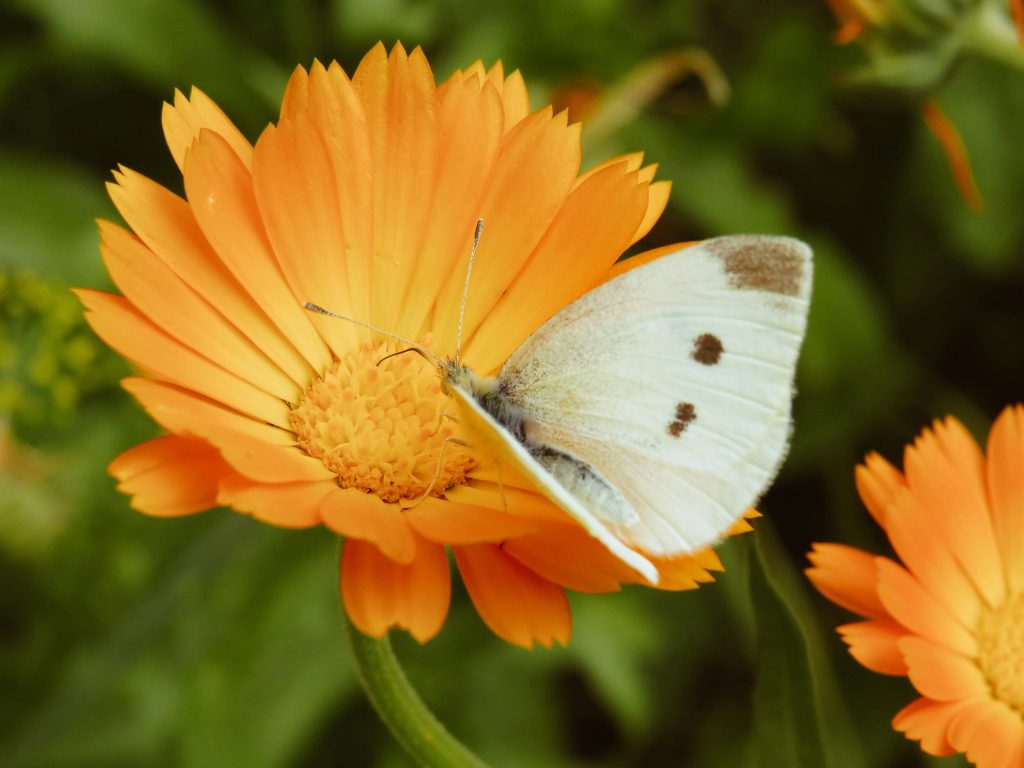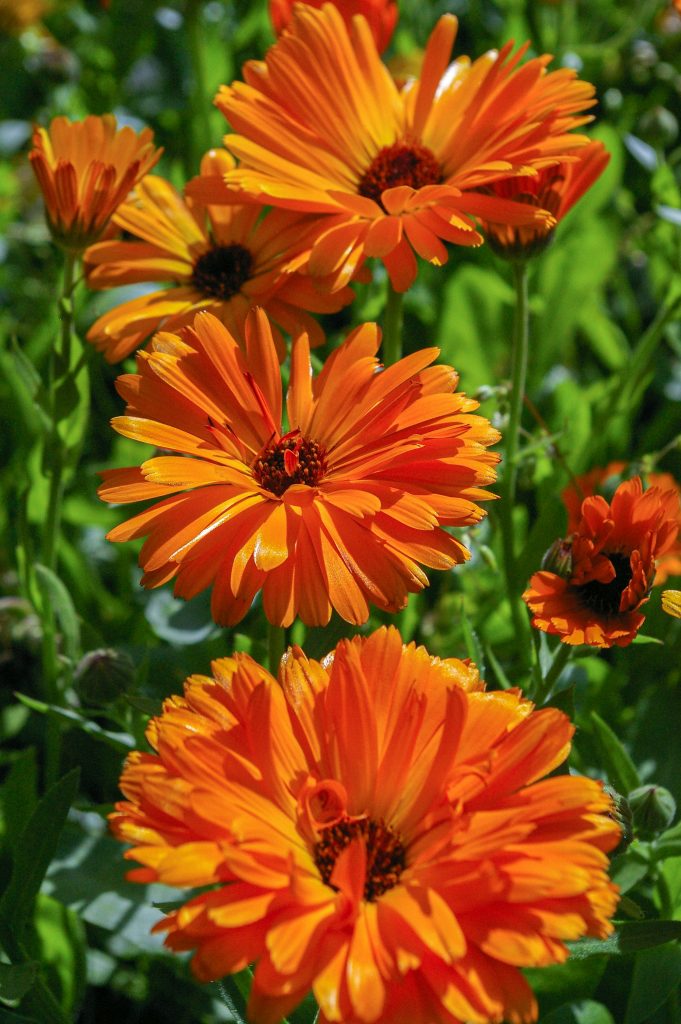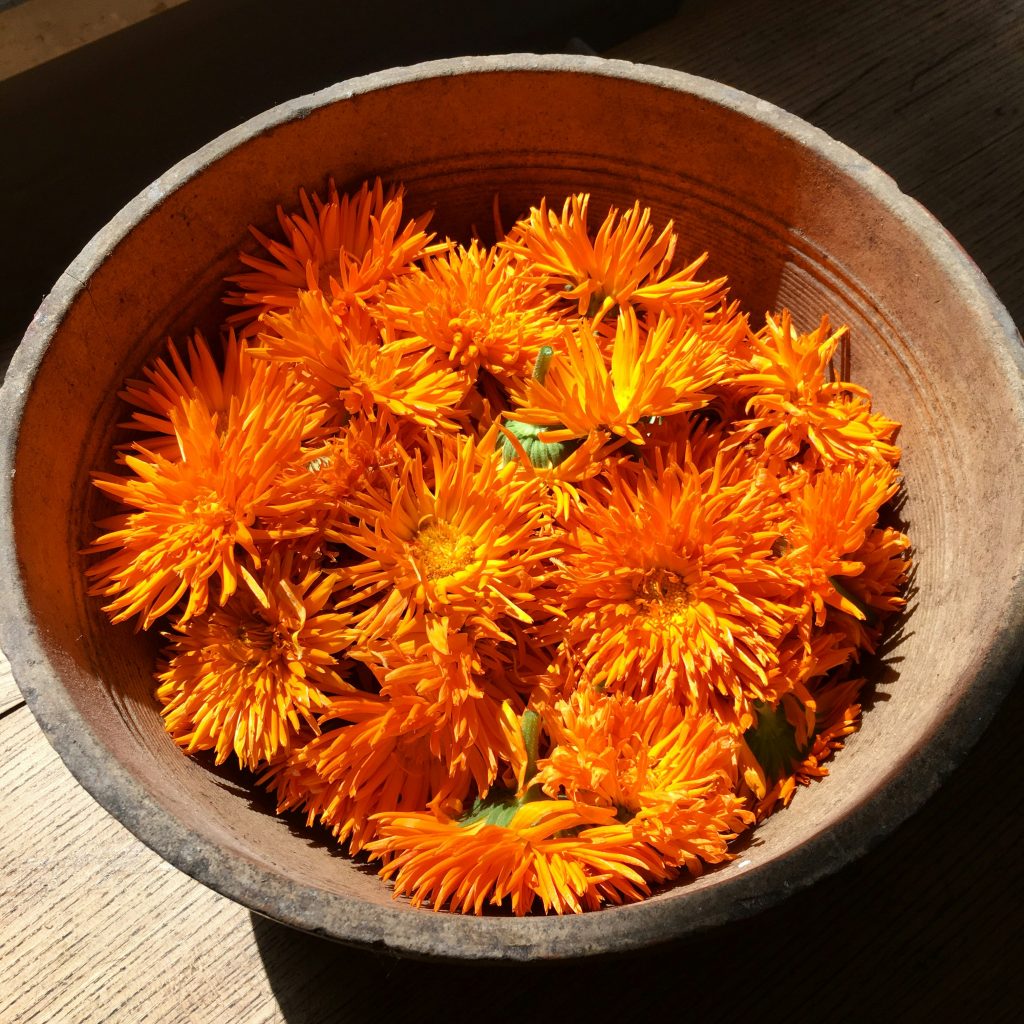Calendula Oil – Beauty and Benefits
Hello, my daring darlings! Today, we’re diving into the wonderful world of calendula oil, that golden elixir that holds a myriad of benefits for our skin, health, and garden. But first, let’s unravel the mystery behind the star of the show – the calendula flower.
What is a Calendula Flower?
Calendula are the perfect representation of a sunny summer flower. Its vibrant hues ranging from sunny yellows to deep oranges, is a sight to behold! This daisy-like bloom, also known as pot marigold, is not just a feast for the eyes but a powerhouse of goodness. Its botanical name, Calendula Officinalis, hints at its esteemed medicinal properties. And, bonus? Deer and rabbits won’t eat them, but pollinators adore them!

Where does Calendula Flower Grow?
Calendula is a versatile little beauty, thriving in various climates and soil types. Originally native to the Mediterranean region, it has spread its roots worldwide, gracing gardens, meadows, and even city sidewalks with its cheerful presence.
Benefits of Calendula Flower
Now, let’s talk about the magic packed within those petals! Calendula isn’t just another pretty face in the garden; it’s a treasure trove of benefits. Calendula oil, extracted from its blossoms, is renowned for its anti-inflammatory, antifungal, and antibacterial properties. From soothing irritated skin to promoting wound healing, this oil is a skincare superhero that you can make from your own backyard.

How to Grow Calendula
Fancy growing your own calendula? It’s easy to grow even for the novice gardener. Simply sow the seeds in well-drained soil, provide ample sunlight, and watch them flourish. They’re perfect for borders, containers, or even as companions to your veggies, attracting beneficial insects while repelling pests. They are cold hardy and can be planted in early spring once the ground is workable. It takes a lot to knock out a calendula plant! If you plan to use this calendula oil on your skin, be mindful of any fertilizers, pesticides or herbicides you choose to use – if any.
Once your plants are in full bloom, you can remove some of the flowers for other applications periodically and you’ll never run out! The calendula plant just keeps on giving.
Controlling Calendula’s Spread in the Garden
While calendula is a beloved addition to any garden, its prolific self-seeding nature can sometimes lead to overzealous spreading. Fear not, fellow gardeners, for there are ways to keep this enthusiastic bloomer in check. Deadhead spent flowers regularly to prevent excessive reseeding, or if you prefer a more hands-on approach, thin out seedlings as needed to maintain control.
In conclusion, dear readers, the humble calendula flower is a true gift from nature, offering beauty, health, and garden benefits in abundance. So why not embrace this golden marvel and let its sunny disposition brighten your days?
How to Process Calendula Oil
Now, the process of turning those sunny blooms into liquid gold! Harvest the flowers when they’re in full bloom, then dry them thoroughly to prevent mold. You can you a dehydrator for this purpose, or just allow the petals to air-dry. Make sure not to crowd them.
Snip or pop off the whole head and allow the petals to dry on them. |The petals aren’t necessary to remove, but the real magic is in the green of a calendula head. Next, infusing the dried petals in a carrier oil, like olive or coconut oil, will make the magic happen over time. To do this, pour your dried calendula heads into a vessel like a mason jar and pack slightly. Pour in your oil to cover the calendula by at least one inch and…voila! You’ve got yourself a bottle of precious calendula oil, ready to work wonders for your skin after just 4-6 weeks at room temperature! After that time, you may want to strain out the petals to make the oil easier to use.

Other Uses for Calendula
But wait, there’s more! Calendula isn’t just limited to skincare. This versatile herb can be brewed into teas, added to salads for a pop of color, or used in culinary creations for a hint of floral flavor. Its medicinal properties extend beyond skincare, with applications in soothing sore throats, alleviating menstrual cramps, and even aiding digestion. Check out this cool blog to see how to process your calendula oil into calendula salve!
Calendula – Body and Soil
Calendula, with its vibrant petals resembling rays of sunshine, not only adds a splash of color to gardens but also boasts a plethora of benefits for both body and soil alike. This resilient flower, known scientifically as Calendula officinalis, has been cherished for centuries for its medicinal properties and aesthetic appeal.
In addition to its renowned skincare benefits, calendula oil can also be utilized in various homemade remedies and wellness practices. From infusing it into soothing balms and salves to incorporating it into massage oils for its anti-inflammatory properties, the possibilities are endless. Furthermore, its antimicrobial properties make it a valuable addition to natural cleaning products, offering a gentle yet effective alternative to harsh chemicals.
Beyond its medicinal and cosmetic uses, calendula plays a vital role in sustainable gardening practices. Its deep taproot helps improve soil structure and fertility, making it an excellent companion plant for vegetables and herbs. Moreover, its ability to attract beneficial insects such as bees and butterflies aids in pollination, contributing to overall garden health and biodiversity.
By embracing the versatility of calendula, we not only nurture our bodies and gardens but also foster a deeper connection with the natural world around us. In essence, the humble calendula flower embodies the essence of beauty, resilience, and harmony—a true testament to the wonders of Mother Nature. So, let us continue to cultivate this golden treasure with reverence and gratitude. And nothing inspires reverence for mother nature more than a vase full of brightly coloured calendula.
